变否定句规则
英语肯定句改否定句口诀

英语肯定句改否定句口诀在英语语法中,人们经常需要将肯定句改为否定句,或者相反。
这是学习英语的一个重要部分,因为能够灵活运用肯定句和否定句的转换,可以使我们的表达更加丰富多样。
本文将为大家介绍一些英语肯定句改否定句的口诀,帮助我们更好地掌握这个技巧。
一、一般句式肯定改否定一般句式的肯定句改为否定句,只需要在动词前面加上"do not"或"does not"即可。
例如:He plays basketball every day.(他每天打篮球。
)→ He does not play basketball every day.(他不是每天打篮球。
)They eat lunch in the cafeteria.(他们在食堂吃午餐。
)→ They do not eat lunch in the cafeteria.(他们不是在食堂吃午餐。
)二、be动词肯定改否定be动词是英语中最常用的动词之一,其肯定形式为"is"、"am"、"are",改为否定形式只需在其后加上"not"即可。
例如:I am a teacher.(我是一名教师。
)→ I am not a teacher.(我不是一名教师。
)They are students.(他们是学生。
)→ They are not students.(他们不是学生。
)三、情态动词肯定改否定情态动词在英语中也占有重要地位,它们有自己的肯定形式和否定形式。
要将肯定形式转化为否定形式,只需在情态动词后面加上"not"即可。
例如:She can swim very well.(她会游泳得很好。
)→ She cannot swim very well.(她游泳不很好。
)You should listen to your parents.(你应该听父母的话。
肯定句改否定句英语

肯定句改否定句英语
一、肯定句改否定句的规则
1.在动词前面加not。
2.有be动词,将be动词提前改成否定形式。
3.有情态动词,将情态动词提前改成否定形式。
4.没有助动词或情态动词,需要添加助动词do或does,然后将动词改为原
型。
二、肯定句改否定句的例子
1.I like English.(我喜欢英语。
)
否定句:I don't like English.
2.He is a student.(他是一个学生。
)
否定句:He is not a student.
3.We can swim.(我们可以游泳。
)
否定句:We cannot swim.
4.They have a book.(他们有一本书。
)
否定句:They do not have a book.
5.My mother is a doctor.(我的妈妈是一位医生。
)
否定句:My mother is not a doctor.
6.The sun rises in the east.(太阳从东方升起。
)
否定句:The sun does not rise in the east.
7.It was Sunday yesterday.(昨天是星期天。
)
否定句:It was not Sunday yesterday.。
陈述句变否定句的规则

陈述句变否定句的规则1. 加上否定词:在陈述句中加上否定词,如"不"、"没有"、"无"、"非"等,来表示否定的意思。
例如:陈述句:他是个好学生。
否定句:他不是个好学生。
2. 改变动词形式:将陈述句中的动词改为否定形式。
例如:陈述句:他喜欢吃苹果。
否定句:他不喜欢吃苹果。
3. 加上反义词:在陈述句中加上表示相反意义的词语。
例如:陈述句:这个房间很干净。
否定句:这个房间不干净。
4. 改变句子结构:改变陈述句的句子结构,使其变为否定句。
例如:陈述句:她是一个聪明的学生。
否定句:没有一个学生聪明如她。
5. 加上条件状语从句:在陈述句中加上条件状语从句,表示不成立的条件。
例如:陈述句:如果他努力学习,他会考上大学。
否定句:如果他不努力学习,他不会考上大学。
6. 加上否定副词:在陈述句中加上否定副词,如"从未"、"决不"、"绝不"等,来表示否定的意思。
例如:陈述句:他总是按时完成任务。
否定句:他从未按时完成任务。
7. 改变句子代词:将陈述句中的代词改为否定形式。
例如:陈述句:我喜欢这本书。
否定句:我不喜欢那本书。
8. 加上否定前缀:在陈述句的形容词、名词前加上否定前缀,表示否定的意思。
例如:陈述句:这个问题很简单。
否定句:这个问题不简单。
9. 改变句子的否定形式:将陈述句改为否定形式,表示相反的意思。
例如:陈述句:他是一个优秀的演员。
否定句:他不是一个优秀的演员。
10. 加上否定连词:在陈述句中加上否定连词,如"但是不"、"然而不"等,表示相反的意思。
例如:陈述句:他虽然帅,但是没有才华。
否定句:他虽然帅,但是没有才华。
11. 加上表示否定的副词:在陈述句中加上表示否定的副词,如"不可能"、"不曾"、"绝不"等,表示否定的意思。
一般现在时变否定句的规则
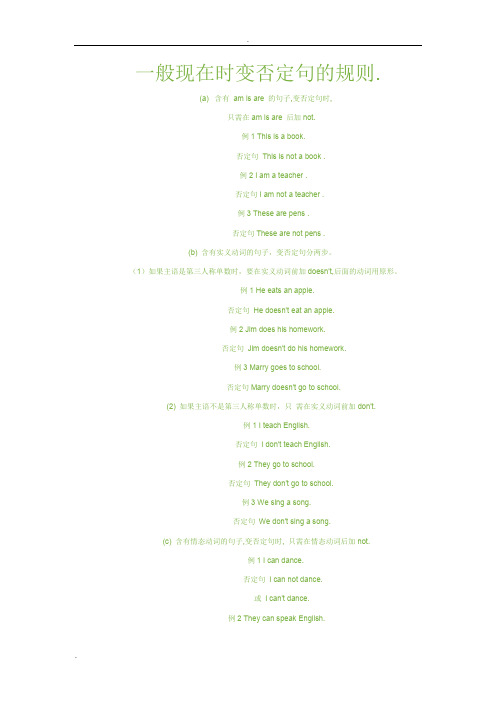
一般现在时变否定句的规则.(a) 含有am is are 的句子,变否定句时,只需在am is are 后加not.例1 This is a book.否定句This is not a book .例2 I am a teacher .否定句I am not a teacher .例3 These are pens .否定句These are not pens .(b) 含有实义动词的句子,变否定句分两步。
(1)如果主语是第三人称单数时,要在实义动词前加doesn't,后面的动词用原形。
例1 He eats an apple.否定句He doesn't eat an apple.例2 Jim does his homework.否定句Jim doesn't do his homework.例3 Marry goes to school.否定句Marry doesn't go to school.(2) 如果主语不是第三人称单数时,只需在实义动词前加don't.例1 I teach English.否定句I don't teach English.例2 They go to school.否定句They don't go to school.例3 We sing a song.否定句We don't sing a song.(c) 含有情态动词的句子,变否定句时, 只需在情态动词后加not.例1 I can dance.否定句I can not dance.或I can't dance.例2 They can speak English.否定句 They can not speak English.或They can't speak English.例3 He must go home.否定句He must not go home.或He mustn't go home.例4 He must be on the playground.He can not be on the playground.析:当must be用来表示推测,有“一定”的含义时,否定式要用can not.例5 You must say something at the mecting.You needn’t say anything at the mecting.析:当“must+行为动词”用来表示“必须”的含义时,其否定式可用needn’t 或mustn't表示“不需要”,“不必”,语气委婉,must not表示“禁止”,“千万别”语气生硬。
变否定句规则
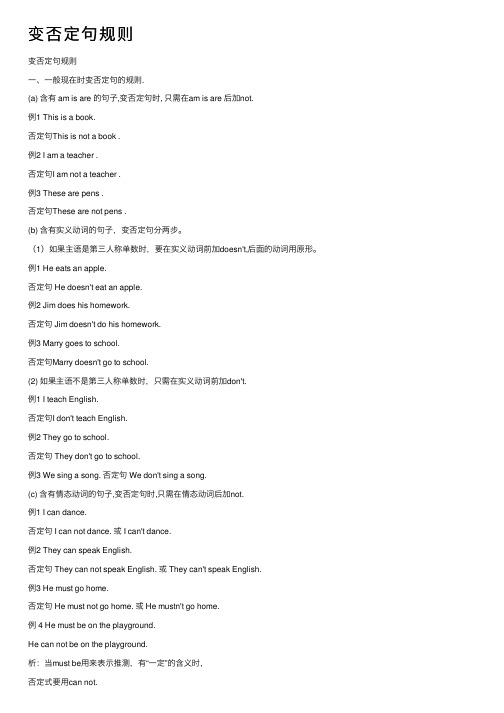
变否定句规则变否定句规则⼀、⼀般现在时变否定句的规则.(a) 含有 am is are 的句⼦,变否定句时, 只需在am is are 后加not.例1 This is a book.否定句This is not a book .例2 I am a teacher .否定句I am not a teacher .例3 These are pens .否定句These are not pens .(b) 含有实义动词的句⼦,变否定句分两步。
(1)如果主语是第三⼈称单数时,要在实义动词前加doesn't,后⾯的动词⽤原形。
例1 He eats an apple.否定句 He doesn't eat an apple.例2 Jim does his homework.否定句 Jim doesn't do his homework.例3 Marry goes to school.否定句Marry doesn't go to school.(2) 如果主语不是第三⼈称单数时,只需在实义动词前加don't.例1 I teach English.否定句I don't teach English.例2 They go to school.否定句 They don't go to school.例3 We sing a song. 否定句 We don't sing a song.(c) 含有情态动词的句⼦,变否定句时,只需在情态动词后加not.例1 I can dance.否定句 I can not dance. 或 I can't dance.例2 They can speak English.否定句 They can not speak English. 或 They can't speak English.例3 He must go home.否定句 He must not go home. 或 He mustn't go home.例 4 He must be on the playground.He can not be on the playground.析:当must be⽤来表⽰推测,有“⼀定”的含义时,否定式要⽤can not.例5You must say something at the mecting.You needn’t say anything at the mecting.析:当“must+⾏为动词”⽤来表⽰“必须”的含义时,其否定式可⽤needn’t 或mustn't表⽰“不需要”,“不必”,语⽓委婉,must not表⽰“禁⽌”,“千万别”语⽓⽣硬。
英语 肯定句变为否定规则
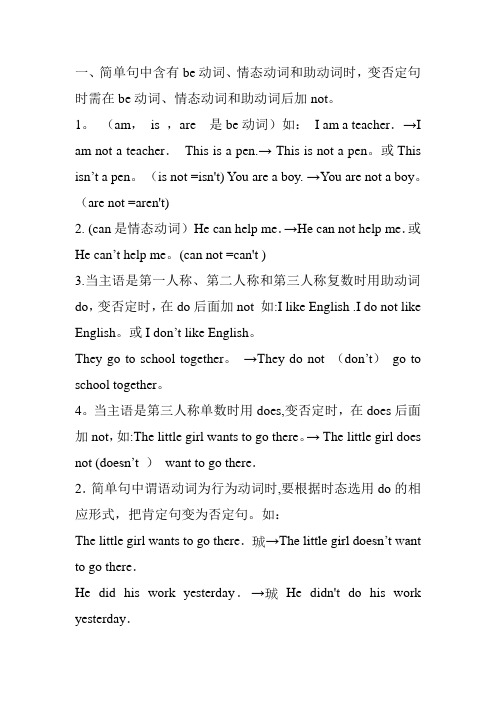
一、简单句中含有be动词、情态动词和助动词时,变否定句时需在be动词、情态动词和助动词后加not。
1。
(am,is ,are 是be动词)如:I am a teacher.→I am not a teacher.This is a pen.→ This is not a pen。
或This isn’t a pen。
(is not =isn't) You are a boy. →You are not a boy。
(are not =aren't)2. (can是情态动词)He can help me.→He can not help me.或He can’t help me。
(can not =can't )3.当主语是第一人称、第二人称和第三人称复数时用助动词do,变否定时,在do后面加not 如:I like English .I do not like English。
或I don’t like English。
They go to school together。
→They do not (don’t)go to school together。
4。
当主语是第三人称单数时用does,变否定时,在does后面加not,如:The little girl wants to go there。
→ The little girl does not (doesn’t )want to go there.2.简单句中谓语动词为行为动词时,要根据时态选用do的相应形式,把肯定句变为否定句。
如:The little girl wants to go there.→The little girl doesn’t want to go there.He did his work yesterday.→He didn't do his work yesterday.3.祈使句变否定句时,一般在句首加Don’t,但Let us或Let’s 开头的祈使句在Let us或Let's后加not也可.如:Put them over there.→Don't put them over there.Let us go home.→Let us not go home.或Don’t let us go home.4.主从复合句中,主句是I think,I believe等结构,变否定句时,形式上否定主句,实际上否定从句.如:I don't think chickens can swim .我认为鸡不会游泳. 5.“had better +动词原形”,变否定句时为“had better not +动词原形”。
肯定句变否定句的规则

肯定句变否定句的规则在英语语法中,将肯定句变成否定句的规则是非常重要的。
在实际的英语交流中,有许多时候需要使用否定句来表达自己的意图,因此掌握这个规则是至关重要的。
在英语中,将肯定句变成否定句有几种方法。
以下是几种最常用的方法:1.将be动词或动词的辅助动词not加在肯定句中。
例如:肯定句:She is happy.否定句:She is not happy.2.使用否定词,如never,not,hardly,scarcely,little 等。
例如:肯定句:I always drink coffee in the morning.否定句:I never drink coffee in the morning.3.使用两个否定词表达肯定的含义。
例如:肯定句:I have nothing to do.否定句:I don't have nothing to do.(=I have something to do.)需要注意的是,否定句中的句子结构常常会发生变化。
例如:肯定句:He speaks English well.否定句:He does not speak English well.在这个例子中,主语和动词之间插入了动词的辅助动词does。
这是因为在一般现在时和一般过去时中,要使用动词的辅助动词来表示否定意义。
此外,某些词语的否定形式也要格外留意。
例如:肯定句:I have some money.否定句:I have no money.肯定句:There is a book on the desk.否定句:There is no book on the desk.总之,在学习英语语法时,将肯定句变成否定句的规则是必不可少的一部分。
只有熟练地掌握了这些规则,才能在实际的英语交流中更自如地表达自己的意图。
英语语法之肯定句变否定句

、语语法之肯定句变否定句一、肯定句变否定句口诀给句子分析它,看它结构是哪个主加be后加not 其他一切全照抄主加动词主重要don't doesn't 来帮忙don't doesn't 中间夹doesn't doesn't 最特殊第三人称单数全靠它二、简单句的句子结构1.主语+be+其他2.主语+动词+其他备注:其中be里包括(am is are)判断下列各句是主语加be还是主语加动词1.I am a girl.2.I like singing.3.We go to school every day.4.They are good friends.5.He works hard.6.She likes playing with toys.7.My mother watches TV every day.8.You are a beautiful girl.9.Tom is playing football on the playground.10.Bill does his homework after supper.三、肯定句变否定句规则肯定句主语+be+其他变成主语+be+not+其他主语+动词+其他变成主语+don't+动词+其他主语(第三人称单数)+动词单三+其他变成主语(第三人称单数)+doesn't +动词原形+其他练习1.She is watching TV now.2.We go to school on Sunday.3.His father works hard.4.Jack's mother is a nurse.5.The cat runs fast.6.They like reading books.7.My grandpa gives me a hot dog.8.Tom often walks to school.9.I have a doll.10.It is eating fish.。
英语肯定句改否定句口诀
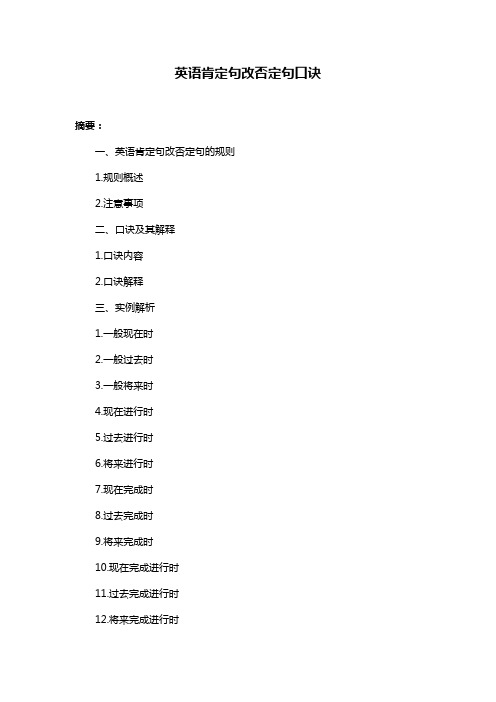
英语肯定句改否定句口诀摘要:一、英语肯定句改否定句的规则1.规则概述2.注意事项二、口诀及其解释1.口诀内容2.口诀解释三、实例解析1.一般现在时2.一般过去时3.一般将来时4.现在进行时5.过去进行时6.将来进行时7.现在完成时8.过去完成时9.将来完成时10.现在完成进行时11.过去完成进行时12.将来完成进行时正文:英语肯定句改否定句是英语语法中的一个重要环节,掌握好这个规则对于英语学习者来说非常关键。
下面,我们通过一个口诀来帮助大家更好地理解和运用这个规则。
一、英语肯定句改否定句的规则1.规则概述在英语中,将肯定句改为否定句主要遵循以下三种规则:(1)在动词前加not(2)借助助动词do, does, did(3)借助助动词have, has, had2.注意事项(1)注意保持时态的一致性(2)注意主语的一致性二、口诀及其解释1.口诀内容“没有(no)要助(do)动,有(yes)要主(have)动。
”2.口诀解释这个口诀简洁明了地概括了英语肯定句改否定句的规则。
当我们需要将一个肯定句改为否定句时,可以根据情况选择使用“没有要助动”或“有要主动”的方法。
三、实例解析以下是一些英语时态的实例,展示了如何将肯定句改为否定句:1.一般现在时肯定句:I study English every day.否定句:I do not study English every day.2.一般过去时肯定句:I studied English yesterday.否定句:I did not study English yesterday.3.一般将来时肯定句:I will study English tomorrow.否定句:I will not study English tomorrow.4.现在进行时肯定句:I am studying English now.否定句:I am not studying English now. 5.过去进行时肯定句:I was studying English then.否定句:I was not studying English then.6.将来进行时肯定句:I will be studying English then.否定句:I will not be studying English then.7.现在完成时肯定句:I have studied English.否定句:I have not studied English.8.过去完成时肯定句:I had studied English.否定句:I had not studied English.9.将来完成时肯定句:I will have studied English.否定句:I will not have studied English.10.现在完成进行时肯定句:I have been studying English.否定句:I have not been studying English.11.过去完成进行时肯定句:I had been studying English.否定句:I had not been studying English.12.将来完成进行时肯定句:I will have been studying English.否定句:I will not have been studying English.通过以上实例和口诀,相信大家对英语肯定句改否定句的规则已经有了更深入的了解。
英语肯定句改为否定句口诀

英语肯定句改为否定句口诀
以下是一些常见的英语肯定句改为否定句的口诀,帮助您快速掌握。
1.一般现在时
-肯定句:主语+动词原形
-否定句:主语+do/does not+动词原形
2.一般过去时
-肯定句:主语+动词过去式
-否定句:主语+did not+动词原形
3.一般将来时
-肯定句:主语+will+动词原形
-否定句:主语+will not/won't+动词原形
4.现在进行时
-肯定句:主语+am/is/are+动词-ing形式
-否定句:主语+am/is/are not+动词-ing形式
5.现在完成时
-肯定句:主语+have/has+过去分词
-否定句:主语+have/has not+过去分词
6.过去进行时
-肯定句:主语+was/were+动词-ing形式
-否定句:主语+was/were not+动词-ing形式
7.过去完成时
-肯定句:主语+had+过去分词
-否定句:主语+had not+过去分词
8.情态动词
-肯定句:主语+情态动词+动词原形
-否定句:主语+情态动词+not+动词原形
9.be动词(一般现在时)
-肯定句:主语+am/is/are
-否定句:主语+am/is/are not
10.be动词(一般过去时)
-肯定句:主语+was/were
-否定句:主语+was/were not
这些口诀可以帮助您快速记住肯定句改为否定句的基本规则。
然而,需要注意的是,有些特殊情况下,否定形式可能会有其他变化或使用不同的词汇。
因此,在具体应用时,仍需结合具体语境和语法规则进行判断和运用。
否定句的变化规则

否定句的变化规则一、含有be动词(am/is/are/was/were)的句子1. 规则- 直接在be动词后加not。
- 例如:- 肯定句:I am a student.- 否定句:I am not a student.- 肯定句:He is at home.- 否定句:He is not (isn't) at home.- 肯定句:They are happy.- 否定句:They are not (aren't) happy.- 肯定句:She was in the park yesterday.- 否定句:She was not (wasn't) in the park yesterday. - 肯定句:We were good friends last year.- 否定句:We were not (weren't) good friends last year.2. 注意事项- 在一般现在时中,am与第一人称I连用;is与第三人称单数(he/she/it 等)连用;are与第二人称you及复数(we/they等)连用。
- 在一般过去时中,was与第一人称I和第三人称单数(he/she/it等)连用;were与第二人称you及复数(we/they等)连用。
二、含有情态动词(can/could/may/might/must/should等)的句子1. 规则- 在情态动词后加not。
- 例如:- 肯定句:He can swim.- 否定句:He can not (can't) swim.- 肯定句:You could play football when you were young.- 否定句:You could not (couldn't) play football when you were young.- 肯定句:She may come tomorrow.- 否定句:She may not come tomorrow.- 肯定句:We must go to school on time.- 否定句:We must not (mustn't) be late for school.- 肯定句:You should study hard.- 否定句:You should not (shouldn't) waste your time.2. 注意事项- mustn't表示“禁止,不许”,有较强的命令语气。
英语 四个基本时态的 肯定句变否定句规则及习题

_______S__h_e__d__o_e__s_n__’t___l_ik__e__b__a_n_a__n_a__s_.______ .
41. Joy has a small T-shirt.
_______J_o_y__d_o_e_s_n__’t__h_a__v_e_a__s_m__a_l_l _T_-_s_h_i_r_t_._____ .
11. Kitty is wearing her new uniform.
_K_i_t_t_y__i_s__n_o_t__w_w__u_n_i_f_o__r_m__. _ .
12. Tom has some apples.
______T_o__m___d_o__e_s_n_’_t__h__a_v_e___a_n_y__a_p__p_l_e_s_.____ .
The old man doesn’t do morning exercises(早操) every morning.
23. We are from China.
_________W___e__a_r__e_n__’t__f__r_o_m___C__h_i_n_a__.________ .
24. He goes to the library(图书馆) on Sundays.
_T_h_e__c_h_i_ld_r_e_n__d_i_d_n_’t__h_a_v_e__a_g_o_o_d__t_im__e_i_n_t_h_e__p_a_r_k..
21. Jim has some story-books.(故事书)
___J__im___d_o__e_s_n_’_t___h_a__v_e__a_n_y___s_t_o__r_y_-_b_o__o_k_s_._ .
英语 肯定句变为否定规则
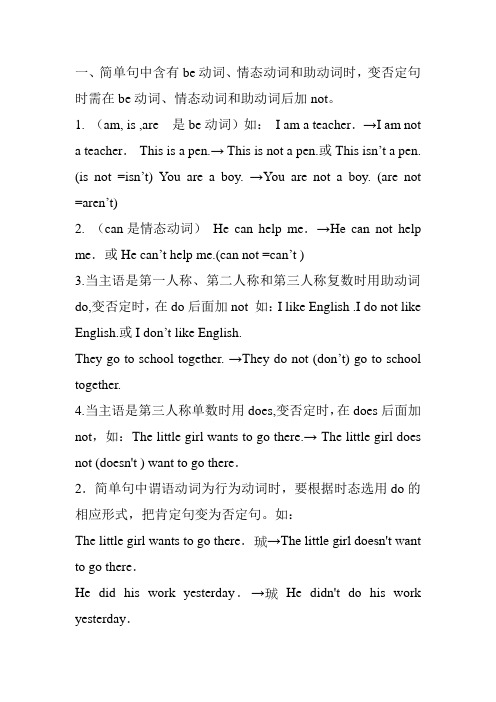
一、简单句中含有be动词、情态动词和助动词时,变否定句时需在be动词、情态动词和助动词后加not。
1. (am, is ,are 是be动词)如:I am a teacher.→I am nota teacher.This is a pen.→ This is not a pen.或This isn’t a pen. (is not =isn’t) You are a boy. →You are not a boy. (are not =aren’t)2. (can是情态动词)He can help me.→He can not help me.或He can’t help me.(can not =can’t )3.当主语是第一人称、第二人称和第三人称复数时用助动词do,变否定时,在do后面加not 如:I like English .I do not like English.或I don’t like English.They go to school together. →They do not (don’t) go to school together.4.当主语是第三人称单数时用does,变否定时,在does后面加not,如:The little girl wants to go there.→ The little girl does not (doesn't ) want to go there.2.简单句中谓语动词为行为动词时,要根据时态选用do的相应形式,把肯定句变为否定句。
如:The little girl wants to go there.→The little girl doesn't want to go there.He did his work yesterday.→He didn't do his work yesterday.3.祈使句变否定句时,一般在句首加Don't,但Let us或Let's 开头的祈使句在Let us或Let's后加not也可。
英语肯定句改否定句口诀
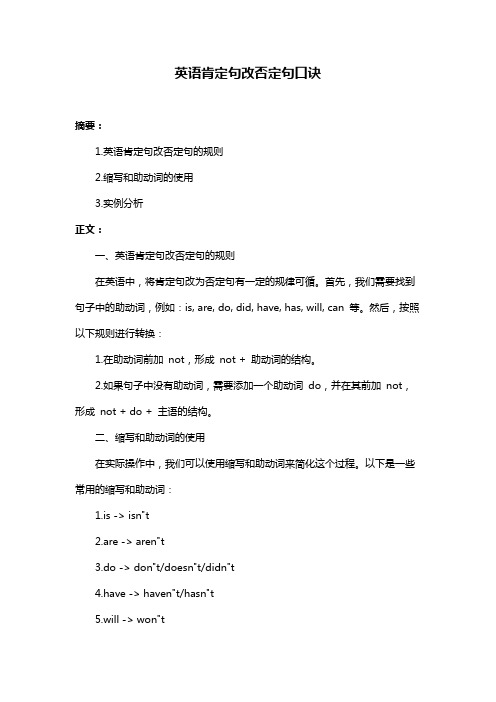
英语肯定句改否定句口诀摘要:1.英语肯定句改否定句的规则2.缩写和助动词的使用3.实例分析正文:一、英语肯定句改否定句的规则在英语中,将肯定句改为否定句有一定的规律可循。
首先,我们需要找到句子中的助动词,例如:is, are, do, did, have, has, will, can 等。
然后,按照以下规则进行转换:1.在助动词前加not,形成not + 助动词的结构。
2.如果句子中没有助动词,需要添加一个助动词do,并在其前加not,形成not + do + 主语的结构。
二、缩写和助动词的使用在实际操作中,我们可以使用缩写和助动词来简化这个过程。
以下是一些常用的缩写和助动词:1.is -> isn"t2.are -> aren"t3.do -> don"t/doesn"t/didn"t4.have -> haven"t/hasn"t5.will -> won"t6.can -> can"t三、实例分析下面我们通过一些实例来具体分析如何使用这些规则:1.肯定句:I am a student.否定句:I am not a student.(直接在am 前加not)2.肯定句:She has a book.否定句:She has not a book.(添加助动词do,并在其前加not)3.肯定句:He will go to the park.否定句:He will not go to the park.(直接在will 前加not)4.肯定句:They can swim.否定句:They cannot swim.(添加助动词can,并在其前加not)通过以上实例,我们可以看出英语肯定句改否定句的方法和规律。
一般现在时变否定句的规则
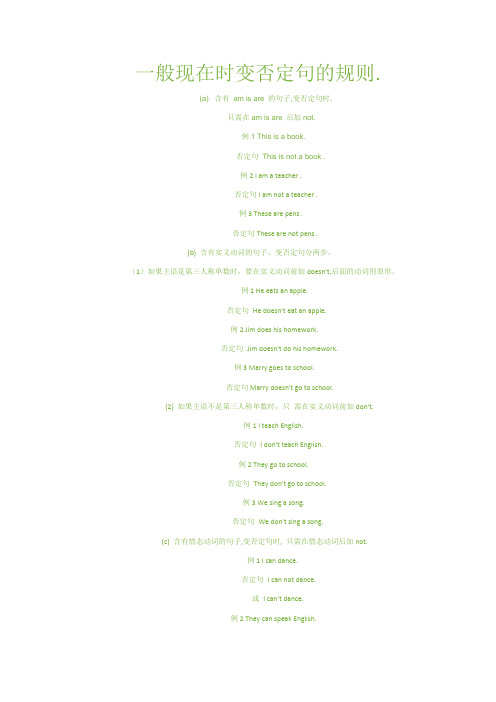
一般现在时变否定句的规则.(a) 含有am is are 的句子,变否定句时,只需在am is are 后加not.例1 This is a book.否定句This is not a book .例2 I am a teacher .否定句I am not a teacher .例3 These are pens .否定句These are not pens .(b) 含有实义动词的句子,变否定句分两步。
(1)如果主语是第三人称单数时,要在实义动词前加doesn't,后面的动词用原形。
例1 He eats an apple.否定句He doesn't eat an apple.例2 Jim does his homework.否定句Jim doesn't do his homework.例3 Marry goes to school.否定句Marry doesn't go to school.(2) 如果主语不是第三人称单数时,只需在实义动词前加don't.例1 I teach English.否定句I don't teach English.例2 They go to school.否定句They don't go to school.例3 We sing a song.否定句We don't sing a song.(c) 含有情态动词的句子,变否定句时, 只需在情态动词后加not.例1 I can dance.否定句I can not dance.或I can't dance.例2 They can speak English.否定句 They can not speak English.或They can't speak English.例3 He must go home.否定句He must not go home.或He mustn't go home.例4 He must be on the playground.He can not be on the playground.析:当must be用来表示推测,有“一定”的含义时,否定式要用can not.例5 You must say something at the mecting.You needn’t say anything at the mecting.析:当“must+行为动词”用来表示“必须”的含义时,其否定式可用needn’t 或mustn't表示“不需要”,“不必”,语气委婉,must not表示“禁止”,“千万别”语气生硬。
如何变否定句
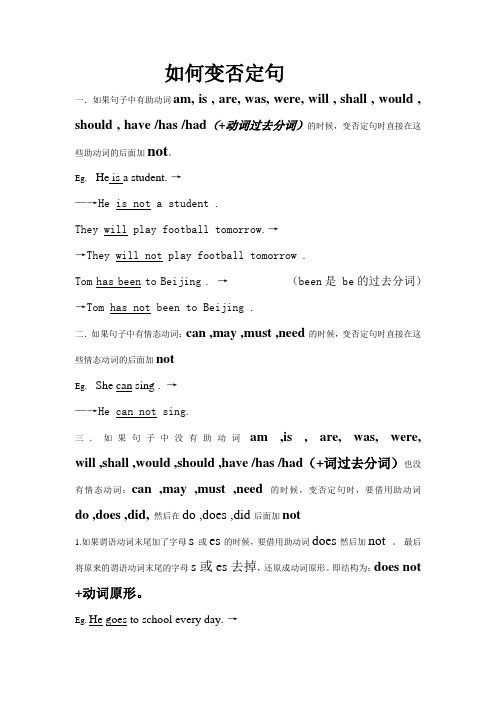
如何变否定句一.如果句子中有助动词am, is , are, was, were, will , shall , would , should , have /has /had(+动词过去分词)的时候,变否定句时直接在这些助动词的后面加not。
Eg. He is a student.→—→He is not a student .They will play football tomorrow.→→They will not play football tomorrow .Tom has been to Beijing . →(been是 be的过去分词)→Tom has not been to Beijing .二.如果句子中有情态动词:can ,may ,must ,need的时候,变否定句时直接在这些情态动词的后面加notEg. She can sing .→—→He can not sing.三.如果句子中没有助动词am ,is , are, was, were, will ,shall ,would ,should ,have /has /had(+词过去分词)也没有情态动词:can ,may ,must ,need的时候,变否定句时,要借用助动词do ,does ,did,然后在do ,does ,did后面加not1.如果谓语动词末尾加了字母s或es的时候,要借用助动词does然后加not 。
最后将原来的谓语动词末尾的字母s或es去掉,还原成动词原形。
即结构为:does not +动词原形。
Eg. He goes to school every day.→→He does not go to school every day.2. 如果谓语动词是has+名词或代词的时候,要借用助动词does然后加not。
最后将原来的谓语动词has还原成动词原形have。
即结构为:does not +动词原形。
- 1、下载文档前请自行甄别文档内容的完整性,平台不提供额外的编辑、内容补充、找答案等附加服务。
- 2、"仅部分预览"的文档,不可在线预览部分如存在完整性等问题,可反馈申请退款(可完整预览的文档不适用该条件!)。
- 3、如文档侵犯您的权益,请联系客服反馈,我们会尽快为您处理(人工客服工作时间:9:00-18:30)。
变否定句规则般现在时变否定句的规则(a) 含有am is are 的句子,变否定句时, 只需在am is are 后加not. 例 1 This is a book.否定句This is not a book .例 2 I am a teacher . 否定句I am not a teacher .例 3 These are pens . 否定句These are not pens .(b) 含有实义动词的句子,变否定句分两步。
(1) 如果主语是第三人称单数时,要在实义动词前加doesn't, 后面的动词用原形。
例 1 He eats an apple. 否定句He doesn't eat an apple.例 2 Jim does his homework. 否定句Jim doesn't do his homework.例 3 Marry goes to school. 否定句Marry doesn't go to school.(2) 如果主语不是第三人称单数时,只需在实义动词前加don't.例 1 I teach English.否定句I don't teach English.例 2 They go to school.否定句They don't go to school.例 3 We sing a song. 否定句We don't sing a song.(c) 含有情态动词的句子,变否定句时,只需在情态动词后加not.例 1 I can dance.否定句I can not dance. 或I can't dance.例 2 They can speak English.否定句They can not speak English. 或They can't speak English.例 3 He must go home.否定句He must not go home. 或He mustn't go home.例 4 He must be on the playground. He can not be on the playground.析:当must be 用来表示推测,有“一定”的含义时,否定式要用can not.例5You must say something at the mecting.You needn ' t say anything at the mecting.析:当“must+行为动词”用来表示“必须”的含义时,其否定式可用needn't或mustn't 表示“不需要”,“不必”,语气委婉,must not 表示“禁止”,“千万别”语气生硬。
例 6 You may come in now.You mustn't come in now.析:may 作为情态动词表示“可以”时,其否定式用must not,而不用maynot.例7 He may watch TV .He mustn't watch TV.(1) 见到some 变否定句时, 要换成any. 例 1 I eat some apples.否定句I don't eat any apples.例 2 He has some books.否定句He doesn't have any books.例 3 He does his home work.否定句He doesn't do his home work.(2) 见到and 变否定句时,要换成or.例 1 There is some air and water on the moon. 否定句There isn't any air or water on the moon.例 2 He has some brothers and sisters. 否定句He hasn't any brothers or sisters.例 3 He eats apples and oranges.否定句He doesn ' t eat apples or oranges.(3) 见到too 和also 变否定句时, 要换成either.例 1. Tom goes to school too.否定句Tom doesn't go to school either.too 和also 用于肯定句中时,否定句中用either 替换。
(4)见到already 变否定句时,要换成yet 。
例 1 He has had supper already.He hasn' t had supper yet.随着对谓语动词的否定,某些副词也要作相应的变动。
英语句型转换错误分析:肯定句变否定句1. I think she is there.误:I think she isn 't there.正:I don't think she is there.析:英语中think, believe, expect, suppose 等表示信念和揣测的动词,后接that 从句时,习惯上将从句中的否定形式转移到主句上,即否定主句谓语,不否定从句谓语。
2. He can sing this song and that one.误:He can not sing this song and that one.正;He can not sing this song or that one.析:肯定句中的连词and 在否定句中一般要改为or 。
3. Tom went to school too.误:Tom didn 't go to school too.正:Tom didn 't go to school either.析:too 和also 用于肯定句中时,否定句中用either 替换。
4. He has had supper already.误:He hasn't had supper aalrdey.正:He hasn't had supper yet.析:随着对谓语动词的否定,某些副词也要作相应的变动。
5. He had a good rest just now.误:He hadn't a good rest just now.正:He didn 't have a good rest just now.析:have 在表示开会、吃饭、休息、进行体育锻炼等词组中是行为动词,否定句用助动词来完成。
6. Let ' s do it. 误:Let's don't do it. 正:Don't let 's 或do Lite. t 's not do it. 析:let 后接的是不带to 的不定式,变为否定式,直接在句首前加Don't或在不定式前加not。
7. He always gets there on time. 误:He doesn't always get there on time. 正:He never getsthere on time.析:He doesn't always get there on time意为“他并非老是准时到那儿”,是部分否定,习惯上把句中的副词改为相应的表示否定的副词即可。
如:It often rains here. It seldom rains here.8. Be here early tomorrow. 误:Be not here early tomorrow. 正:Don't be heree arlytomorrow. 析:祈使句的否定,一般在谓语动词前加do not 的缩写don'。
t9. You had better come. 误:You didn 't have better come. 正:You had better not come. 析:had better 相当于一情态动词,不可分割,因此not 应放在其后。
would rather 也是如此。
10. Both Tom and Xiao Ping went to school. 误:Both Tom and Xiao Ping didn 't go to school. 正:Neither Tom nor Xiao Ping went to school. 析:一个句子中如果有不定代词both ,all, every 改为否定式时,要把这些不定代词改为相应的表示否定的代词。
二一般过去时变否定句规则(a) 含有was were 的句子,变否定句时,只需在was were 后加not. 例1 This was abook.否定句This was not a book . 或This wasn't a book . 例 2 I was a teacher .否定句I was not a teacher . 或I wasn't a teacher .例 3 These were pens .否定句These were not pens 或. These weren't pens(b) 含有实义动词过去式的句子,变否定句时,只需在实义动词过去式前加didn't ,后面的动词用原形。
例 1 He ate an apple.否定句He didn't eat an apple.例 2 Jim did his homework. 否定句Jim didn't do his homework.例 3 Marry went to school. 否定句Marry didn't go to school.(c) 含有情态动词过去式的句子,变否定句时,只需在情态动词过去式后加not.(can could,may might ,need need ,must must)例 1 I could dance.否定句I could not dance.或I couldn ' t dance.例 2 They could speak English.否定句They could not speak English.或They couldn ' t speak English.例 3 He could swim,so can I.He could swim,neither(nor)can I析:在“陈述句+so+助(系情态)动词+主语”结构中,若改为否定句,除陈述部分加副词not 外,还需将so 改为neither 或nor 。
